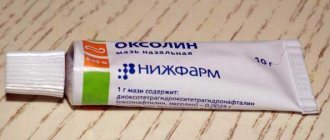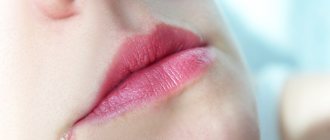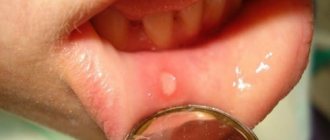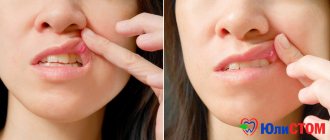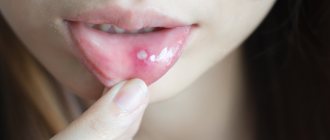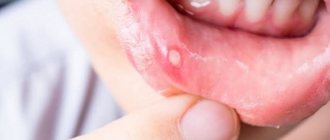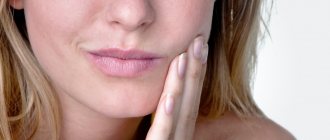September 23, 2021
Aphthous stomatitis is one of the most common inflammatory diseases of the oral cavity.
Aphthous stomatitis is one of the most common inflammatory diseases of the oral cavity. In this article we will tell you what additional examinations should be performed for recurrent stomatitis and how to treat this disease.
Stomatitis affects from 10 to 40% of the world's population. The diagnosis occurs with equal frequency in people in adulthood and childhood. Clinically, stomatitis manifests itself in the form of painful ulcers on the oral mucosa. Such formations are called aphthae. These pathological lesions are round, bright yellow formations with a bright red inflammatory rim in a circle. They can be located anywhere in the mouth, even on the tongue or gum. Sometimes there are multiple rashes.
The most common causes of stomatitis include viral or bacterial infections. Bacterial stomatitis is usually the result of dental problems and poor oral hygiene (for example, not brushing your teeth thoroughly enough). Sometimes aphthous stomatitis appears at the site of injury, burn or abrasion of the mucous membrane. Canker sores may also appear as a result of taking systemic antibacterial drugs.
What is Oxolinic ointment?
This is a pasty viscous substance based on oxoline. The ointment has a yellow tint, a homogeneous, slightly oily structure. Plastic, easily distributed over surfaces. After long-term storage, the product sometimes becomes pinkish or bluish. This feature does not affect its properties.
The medicine is released in different concentrations:
- with oxoline content 0.25%: in tubes of 10 g, used for the treatment of mucous membranes;
- with an active ingredient content of 3%: packaged in tubes of 10–30 g, suitable for treating skin or eliminating intense pathological processes.
Auxiliary compounds of the drug: wax, paraffin, vaseline oil.
General effect of the drug
At the initial stages of the development of the disease, antiviral drugs are effective, among which Acyclovir is the most common and accessible. The product is actively used to treat skin lesions, including the oral mucosa. The release form of the drug is different:
- Tablets 200 mg;
- Ointment for external use 5% and for eyes 3%;
- Lyophilisate in a bottle, for preparing a solution for injections.
For systemic therapy, the tablet form is prescribed. The affected areas must be smeared with Acyclovir, intended for external use. The ointment is often prescribed for the treatment of herpes lesions and stomatitis in the mouth in order to achieve antiviral and anti-inflammatory effects. Efficiency is achieved when using the medicine in the first days of the appearance of signs of the disease.
Action of Acyclovir:
- The risk of new rashes in the mouth is reduced;
- Pain syndrome is relieved;
- The tissues heal quickly.
How does Oxolinic ointment work?
The drug disrupts the integrity of the cell membranes of pathogens, causing their death. When applied to the surface of the skin and mucous membranes, the ointment mechanically prevents their infection, softens, and reduces the symptoms of inflammation. Oxolin affects pathogens of influenza, molluscum contagiosum, herpes simplex, adenoviruses, and rhinoviruses.
The use of ointment does not lead to a systemic effect on the body. The amount of oxoline that penetrates through the capillaries into the blood is insignificant. The product does not accumulate in tissues and has no cumulative effect. Particles that get inside are completely metabolized.
Symptoms of stomatitis
- soreness of the oral cavity;
- bad breath;
- formation of ulcers in the mouth;
- increased body temperature (in severe and widespread form).
At the initial stage of stomatitis, the oral mucosa dries out in the affected areas and becomes shiny. After 1–2 days, a barely noticeable white coating appears. At the next stage of stomatitis, ulcers appear, which are called aphthae. The chronic form of stomatitis is diagnosed when several pathological lesions form in the oral cavity more often than once a year.
When to use Oxolinic ointment
Traditionally, the medicine is used during respiratory epidemics and when communicating with possible carriers of influenza viruses. The list of indications for use of the drug includes:
- influenza and other respiratory viral pathologies;
- blepharitis;
- inflammation of the conjunctiva;
- lichen lesions;
- molluscum contagiosum;
- dermatitis;
- herpes stomatitis;
- skin warts of viral origin.
The use of medicine for preventive purposes and at an early stage of pathologies is more effective than for advanced infections. To achieve a pronounced therapeutic effect, this drug must be combined with other drugs.
Diagnostics
Most often, the diagnosis is made by a dentist after examining the oral cavity. In some cases, the doctor may prescribe additional examinations (bacterial culture, PCR smear, etc.) to detect candidiasis or the herpes virus. In case of massive damage to the oral cavity (severe forms of stomatitis), it is necessary to conduct a blood test and seek advice from a therapist. During diagnosis, it is important to distinguish between herpetic and aphthous forms of stomatitis, since different special therapy is chosen for them.
Side effects of the ointment
When first applied, a slight burning sensation, increased runny nose, and irritation of the integument are likely to occur. With prolonged daily use, the nasal mucosa may feel dry. The risk of drying out is especially high during simultaneous treatment with vasoconstrictor drops. With proper use of the product, the discomfort gradually goes away on its own. If symptoms increase over time, the ointment should be discarded, as an allergic reaction is possible.
Oxolinic ointment does not affect the speed of psychomotor reactions and the activity of the central nervous system; it is allowed when driving vehicles and operating complex equipment.
Disease prevention
To prevent the disease from developing or becoming chronic, it is necessary to keep your mouth clean, eat well, and give up smoking and other bad habits. It is important to promptly treat other oral diseases, such as periodontitis, gingivitis, glossitis, caries. If you suffer from chronic stomatitis, regular visits to the dentist are recommended. It is necessary to pay attention to the general condition of the body, monitor the state of the gastrointestinal tract and cardiovascular system, take vitamin complexes, get adequate sleep and lead an active lifestyle. As a preventative measure, you can rinse your mouth with a decoction of chamomile or sage, as well as warm saline solution.
Acyclovir ointment for external use
For external use, Acyclovir is available in the form of an ointment or cream, the percentage of the active active substance Acyclovir is up to 5. Tubes are available in volumes of 2, 5, 10 g. The product is applied to the rash in a thin layer, without rubbing it into the epidermis, as a rule, the prescribed frequency of application is 5 times a day. The duration of treatment is prescribed by the attending physician and ranges from 5 to 10 days.
Treatment begins at the first symptoms:
- Itching at the site of inflammation;
- Painful sensations;
- The appearance of the first bullae;
- Feeling of skin tightness and burning.
The end of treatment should occur no earlier than 2 days after the inflammation disappears.
Side effects:
- Irritation;
- Itching;
- Edema.
If any allergic reactions occur, the drug should be discontinued and consult a doctor to prescribe another drug.
Acyclovir in ointment form is not prescribed to persons:
- Pregnant women;
- Breastfeeding women.
It is permissible to prescribe treatment using Acyclovir ointment for a pregnant woman, provided that the benefit to the mother's health will be significantly greater than the risk to the health of the child.
Causes
Often a child gets sick for the first time during teething. It prevents you from brushing the area where the tooth is erupting. As a result, infection accumulates in this place and inflammation of the gum tissue occurs, which gradually spreads. It is aggravated by frequent allergic reactions to introduced complementary foods.
In older children, pathology is provoked by the following reasons:
- mechanical microtraumas - damage to gum tissue occurs when brushing teeth with hard brushes or hard food when biting it;
- the introduction of herpes is provoked by other viral or infectious lesions of the oral cavity;
- the presence of polyps in the nasal cavity and breathing problems contribute to the penetration of an infectious agent into the gum tissue;
- an incorrect bite in a child leads to constant trauma to the mucous membrane and the development of inflammation;
- lack of nutrients, vitamins and microelements in the baby’s diet reduces local immunity;
- the manifestation of a viral infection is provoked by burns in the mouth;
- Dental diseases (caries, pulpitis) contribute to the development of the virus in the gum tissue, weakening local immunity.
The infection spreads to other tissues quite quickly, and isolated gum damage spreads to periodontal structures.
Treatment
Treatment of mild forms of herpetic gingivitis in children is carried out on an outpatient basis under the supervision of a physician. In severe cases of the disease, the patient is hospitalized in a hospital. The patient is prescribed a diet with a predominance of pureed food that does not irritate the oral mucosa. It shouldn't be hot. There is no need to give your child solid food to prevent additional injury to the gums.
For mild forms, local treatment is used.
The following drugs are used:
- antiviral agents (Acicovir, Ganciclovir) - destroy the DNA of the virus, use ointment to lubricate the gums up to five times a day for two weeks;
- local anesthetic gels and ointments (Lidochlor gel, Kamistad) - they anesthetize, disinfect, have an anti-inflammatory effect, are used three times a day, two weeks;
- local antiseptics (Iodinol, Miramistin, Hexoral) - these agents rinse the mouth every four hours, two weeks;
- reparative preparations (Solcoseryl-gel, Methyluracil ointment) - applying ointments to ulcers promotes their epithelization and rapid healing, applied three times a day for two weeks.
Herbal infusions (chamomile, rose hips, calendula, sage, St. John's wort, licorice) are widely used for rinsing when gums are damaged.
In severe cases, the baby is prescribed oral medications.
The following drugs are prescribed:
- antiviral drugs (Famciclovir, Acyclovir, Zovirax) - taken according to the regimen prescribed by the doctor, the drug must be taken to the end, otherwise there will be a relapse;
- antihistamines (Suprastin, Tavegil, Citrine) - reduce swelling of gum tissue and reduce pain;
- antipyretics (Panadol, Nurofen) are used to reduce high fever.
Parents should monitor the baby’s oral hygiene; during illness, it is carried out especially carefully. To prevent gum injury, it is recommended to use toothbrushes with soft bristles. It is necessary to treat toys and objects that the baby uses with antiseptics.
What kind of pathology is this
Herpetic gingivitis is an inflammatory lesion of the gums caused by the introduction of a herpes viral infection into their mucosa. This infection is considered highly contagious and can be contracted anywhere, on the street and in public places. During the cold season, there are more cases of this infection. Its source is a sick person. Often this disease becomes a complication of viral stomatitis.
The virus is transmitted to children in the following ways:
- contact;
- household;
- airborne;
- hematogenous.
The first introduction of the virus into the baby’s body is manifested by gingivitis and stomatitis.
Is it possible to smear Acyclovir into the mouth?
Acyclovir ointment should not be used in the mouth. Reasons why the use of ointment on the oral mucosa is not allowed:
- The risk of a local inflammatory reaction on the oral mucosa;
- Nausea;
- Vomit;
- Pain in the epigastric region;
- Diarrhea;
- Allergic reaction.
The active ingredient of the drug, namely acyclovir, is a strong irritant to the oral mucosa. Also, the cream and ointment contain a lot of ballast substance, which is not allowed to be swallowed. These substances, entering the body in a similar way, cause the listed disorders of the gastrointestinal tract.
The most common allergic reactions include urticaria and dermatitis of an allergic nature . However, cases of development of more serious reactions to the components of the drug that cause severe complications, such as Quincke's edema and anaphylactic shock, cannot be excluded.
To summarize, we can say that Acyclovir ointment cannot be used on the oral mucosa; you can smear other equally effective antiviral agents in the mouth, such as Viferon gel and Oxolinic ointment. You can also use the combined product Vinilin to treat the oral mucosa. All forms of the drug should be used only as prescribed by a doctor and in accordance with the instructions, following the recommended routes of administration of the drug.
